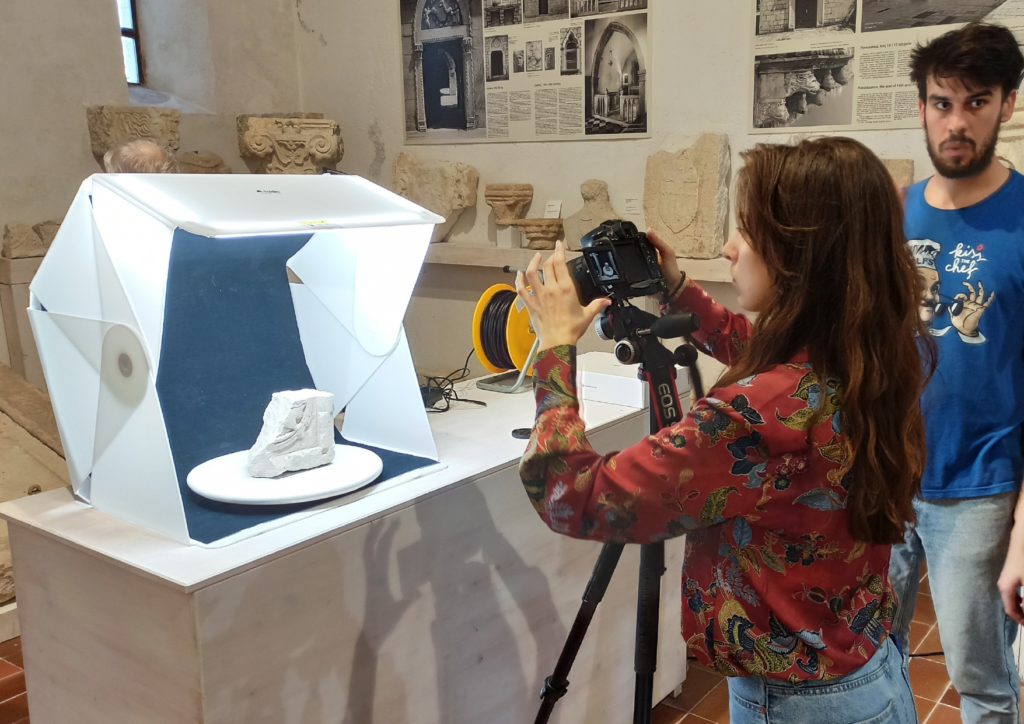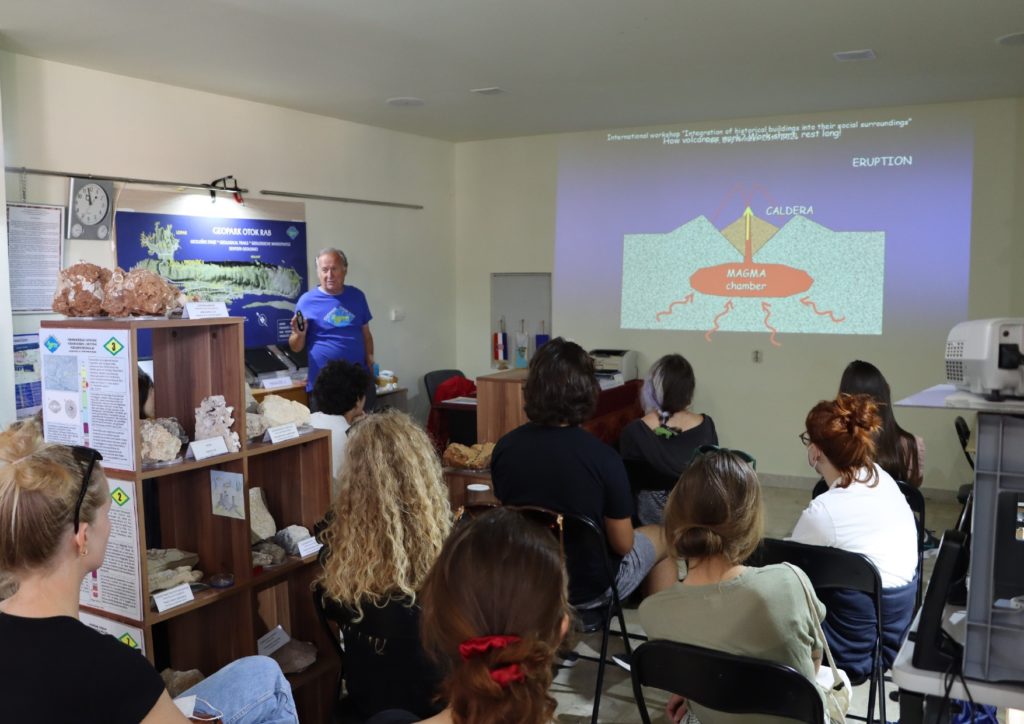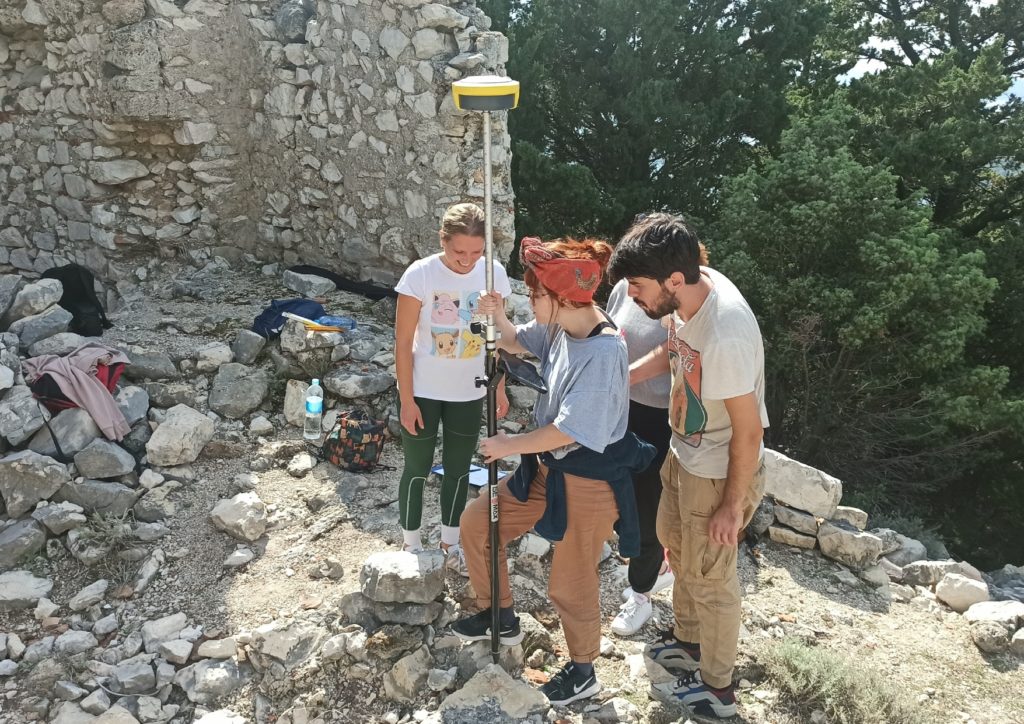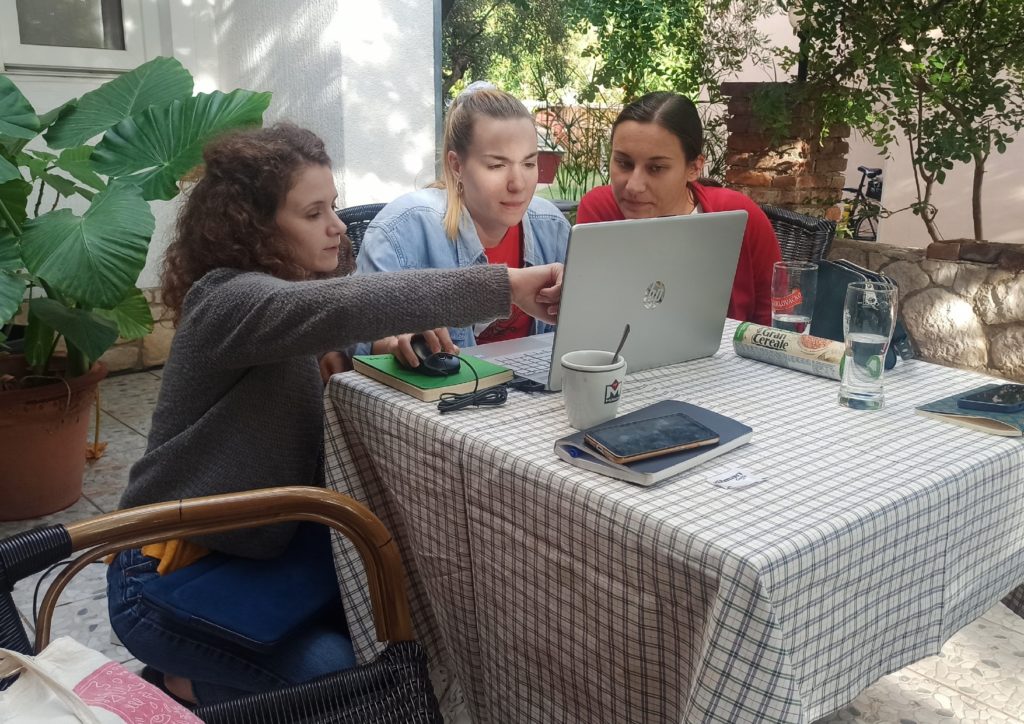HILAR workshop: Rab (Sept 20th – Oct 4th 2021)
The primary goal of the workshop conducted on the island of Rab (20th September – 3rd October) was to present a few key components of the contemporary approach to the historic landscape recording and the related societal problems. As the name of the workshop implies (Integration of Historical Buildings into their Social Surroundings), a stress was put on the social aspects of a heritage buildings, as an integral part of their role in landscape formation – both historic and contemporary. As it presents a complex problem concerning multiple disciplines and fields, the workshop likewise included multiple interdisciplinary approaches and answers. Workshop thus included lectures both by project team members, as well as an array of guest lecturers from various scientific fields. Those included art historians, but also archaeologists, sociologists, historians, geologists and conservation experts. Following that very philosophy, students were chosen based on their study program. The goal was to choose students with different specializations – all connected in various ways to historic heritage preservation.
The workshop was built upon research by project collaborators as well as years of previous research activities conducted on the island of Rab by the International Research Center for Late Antiquity and Middle Ages (IRCLAMA) team and the partners from other universities, starting with 2005 and the research campaign on Kaštelina, and continuing with various different campaigns on the entire island. Both the urban and rural contexts were explored, as well as various types of architectural heritage: fortresses, churches/related sacral architecture and residential architecture. The results of previous IRCLAMA research activities, with an emphasis on the problems related to the historic landscape research and management were presented by research assistant Ivor Kranjec. The island of Rab was chosen as a workshop location because it represents a small island community with a rich heritage that is yet to be properly evaluated, which is a reality for many of the Eastern-Adriatic island communities.
The workshop program can be divided in two different sections, concerned with different goals and/or approaches to heritage buildings and historic landscape. It was strategically designed to combine various scientific fields, different work methods (both lab/field work and practice sessions, as well as classroom lectures) and to maximize the potential held by inclusive participant list.
CONTEMPRORARY METHODS IN HERITAGE DOCUMENTATION
First of all, during the workshop, students have received the practical knowledge and a critical/historical overview of the contemporary methodology of historic building/landscape documentation. PostDoc P. Vedovetto, PhD from the University of Padua gave a lecture on documentation and interpretation of sculpture, as well as practical course on the implementation of CAD tools for the digitization of the cultural heritage (Autodesk AutoCAD). The multi-part sessions conducted by PostDoc J. Behaim gave an extensive overview of use of photogrammetry for the heritage related studies. Students thus gained knowledge about the use of an approachable method of 3D model creation and historical architecture/movable object documentation. With a focus of project on the landscape related problems, a big emphasis was put on the use and implementation of GIS (geographic information system) framework related approaches. A majority of work was done using GIS softwar, but since the project strives for a critical approach to the digital technology use, a lecture presenting theoretical basis opened the practice sessions. Research assistant Ivor Kranjec gave a lecture about the use of cartographic sources and their potential for scientific research and historic landscape reconstruction. After students received the necessary context, the practical work on the reconstruction of historical route networks of Eastern Adriatic have started. The work in GIS framework was complemented by another practice session, this one concerned with Rab’s historical centre. Combining various skills developed during the practicum of the workshop, students worked on data acquisition on the field, and later on, on its implementation, input and analysis using the GIS framework.
Further scientific possibilities of implementation of modern digital technologies were presented by guest lecturers PostDoc Michelle Beghelli and Joan Pinar Gil. Their lecture presented innovative statistics oriented method of correspondence analysis in the context of both the early medieval sculpture and the archaeological findings in broader sense.
Following the interdisciplinary nature of workshop, a lecture was given by a geologist T. Marjanac, PhD from Rab Geopark institution. The lecture focused of preservation of geological heritage, as an important aspect of historical landscape as a whole. As participating students are specializing in art history, history, sociology or archaeology, this lecture has given them new information and emphasized the importance of close collaboration with specialists in different fields. The program also included a hybrid session with project partners from Cyprus. Two lectures were given by project team members N. Bakirtzis and PostDoc M. Trentin, both serving as practical examples of research methods HILAR project strives to promote. Hybrid session was closed with a practice session by Jelena Behaim that stressed the importance of transversal skills.

SOCIOLOGICAL ASPECTS OF HERITAGE PRESERVATION AND RELATED SURVEY
The second, parallel, section of the workshop was aimed at teaching the importance of “seeing the bigger picture” i. e. to put the architectural heritage and landscape into its social context.
On the first day of the workshop, the students were acquainted with the general history of the island, given to them by the guest lecturer, professor Neven Budak, PhD. They were given an insight into the good practice of intelligent heritage management through the presentation of the results of the COST Action TD1406 – Innovation in Intelligent Management of Heritage Buildings (i2MHB), by PostDoc Jelena Behaim, PhD and research assist. Ivor Kranjec. This lecture was complemented with a following lecture by J. Behaim, about the importance of research the heritage buildings and their surroundings as a whole, especially in the context of their preservation and presentation.
After such general overview, on the participants were given lecture about researching the social aspects of various important segments of their own specializations – such as sculpture as a material source for social history. Professor A. Chavarria Arnau, PhD, introduced them to legal basis of the heritage preservation praxis through her lecture on the European conventions concerning cultural heritage. This was complemented by her lecture that followed the next day about the examples of good practice in Italy, in which she emphasized the Italian model of participation and inclusion of various users of heritage in the discussion about its preservation. On the day 12 of the workshop, professor Marijan Bradanović, PhD, has introduced the participants to practical guidelines in the protection of endangered heritage, based on his own experiences as a long-time conservator.
Throughout workshop’s duration, a sociological survey has been conducted, aimed at investigating the relationship between the local communities and their heritage: heritage buildings, historical centres, historical landscapes, movable and intangible heritage. Survey was under leadership of professor Jana Vukić, PhD, an expert in the field of sociology of space who on the 2nd day of workshop gave a lecture on the methodology and methods of sociological research to introduce the survey to the participants, along with the lecture from research assist. Ivor Kranjec and L. Rajčić. The survey was conducted in the form of a questionnaire given to the inhabitants of Rab, as well as in the form of a structured interview with the selected examinees (including locals, various experts and stakeholders). Such example of sociological survey is a pilot project of the research of potential participation of locals in the heritage management processes. Because of its excellent results (more than 160 participants in the survey) expected to be implemented in the other Eastern-Adriatic communities.

FIELD WORK
The workshop also included several field excursions that gave the students an opportunity to experience the current state of preservation of heritage in the context of rural and urban island landscape. Field survey was conducted by Ivor Kranjec near the Gožinka cove, both on the site of “Ciprijanovo”, as well as on the site of a probable Roman residential-productive complex in its vicinity. Other field sessions included a visit to the sites of Late Antique fortress of St. Cosmas and Damian, 11th century reformed monastery of St. Peter in Supetarska Draga, sacral complex of St. Stephen in Barbat and the restaurant Barbat in its vicinity. The goal was to present various types of heritage buildings and related objects in different landscape contexts to the students and show them a wide scope of sites with different stages of preservation and presentation. From the still in function church of St. Peter in Supetarska Draga, to the excavated and presented site of St. Cosmas and Damian, the question of role of a preservation of site, not only in material sense, but in collective memory was arisen and discussed during the excursions. The case of Barbat restaurant presents an example of heritage object preservation in private context and initiative without the state sponsorship. Future possibilities of all of the visited sites, and methods of achieving those goals were discussed during the excursion. Other field work included already mentioned data acquisition activities in Rab’s historical centre, work on documentation of sculpture in Rab lapidarium, and the activities related to the sociological survey of island’s population.
.

CONCLUSION
Workshop thus worked with two parallel programs. One was concerned with a presentation and implementation of a modern art historical/archaeological methods that served as a test of sorts for the WIP curricula of the master study of Landscape cultural heritage manager. Presented approaches will serve both as examples of good practice, but have also presented a methodological basis for the data acquisition for the fragment of materials needed both for the course development and its execution. Following the philosophy of interdisciplinarity and inclusion, workshop has connected both the researchers and students of multiple scientific fields. Selected lectures and work sessions were given to all of the workshop participants in order to promote the good practices, knowledge and experience exchange, as well as networking which today represents one of the key requirements of job market.
During the workshop students were presented with various approaches to the problems of heritage: its role in landscape formation, identity and social integration. From the work concerning the state-of-the-art documentation methods, to the understanding of the monument for the communal identity and the preservation of their memory. Conducted survey was deemed successful with a relevant statistical sample, and it served as our barrier breaker between disciplines that should not be considered as separate. It has provided students theoretical and practical skills that are very important for contemporary job market in heritage management/preservation and related fields. The results of the workshop will be used to enhance work on the IO (intellectual output) of the project HILAR which is the master course in Landscape cultural heritage manager. The workshop used material and research done by project collaborators for the creation of curriculum of the aforementioned master study. These included: Ivor Kranjec (Sociological aspects in historic landscape education), Palmira Krleža (Function of architectural heritage in teaching about historic landscapes in higher education) and Filip Lovrić (Functions of 3D models in architecture about historic landscapes in higher education).
You can download the programme of the workshop here.
.
